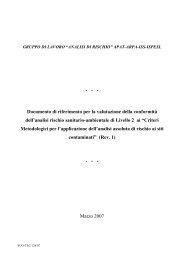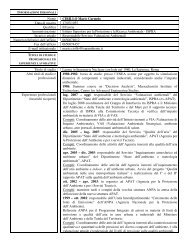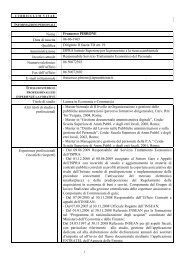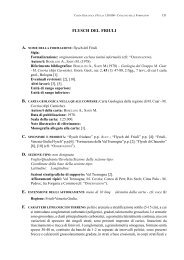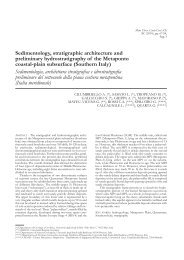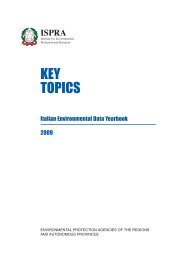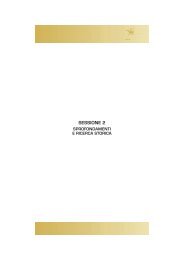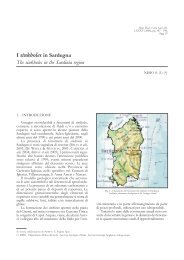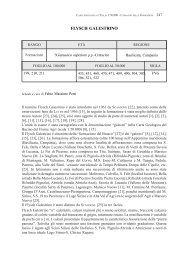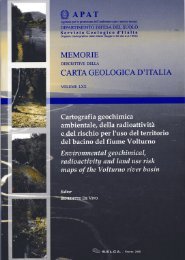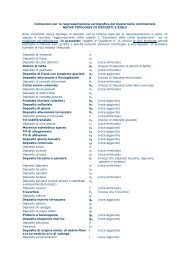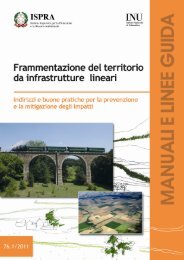Chiocchini M. - Ispra
Chiocchini M. - Ispra
Chiocchini M. - Ispra
Create successful ePaper yourself
Turn your PDF publications into a flip-book with our unique Google optimized e-Paper software.
The new genus Palaeocornuloculina (Foraminiferida,<br />
Cornuspiracea) and its species from Cenomanian<br />
limestones of Southern Latium (Central Italy)<br />
Il nuovo genere Palaeocornuloculina (Foraminiferida, Cornuspiracea)<br />
e le sue specie nei calcari cenomaniani del Lazio meridionale (Italia centrale)<br />
ABSTRACT - Palaeocornuloculina n. gen. and three new species<br />
from carbonate stratigraphic successions of Southern<br />
Latium are here described: Palaeocornuloculina lepina n. gen.,<br />
n. sp. has been observed in the Lower Cenomanian of<br />
Lepini Mountains, Palaeocornuloculina triangularis n. gen., n.<br />
sp. and Palaeocornuloculina ausonensis n. gen., n. sp. occur<br />
rispectively in the Lower Cenomanian and in the Upper<br />
Cenomanian of Ausoni Mountains.<br />
The mentioned species are very significant for their restricted<br />
stratigraphic extension and as paleoenvironmental indicators,<br />
because they have been observed only in the inner<br />
shelf facies of Latium-Abruzzi sector of the Apennine<br />
Platform (sensu MERLINI & MOSTARDINI, 1986).<br />
In the end the stratigraphic extension of the most important<br />
benthic foraminifers and calcareous algae in the<br />
Cenomanian and Lower Turonian limestones of Southern<br />
Latium is specified.<br />
KEY WORDS: Foraminifers (Cornuspiracea), systematic,<br />
stratigraphy, paleoecology, Cenomanian, Southern Latium,<br />
Central Italy.<br />
RIASSUNTO - Vengono descritte tre nuove specie di foraminiferi<br />
bentonici porcellanacei riferite al nuovo genere<br />
Palaeocornuloculina, individuate nei sedimenti carbonatici del<br />
Cretacico superiore, ampiamente affioranti nel Lazio meridionale.<br />
In particolare Palaeocornuloculina lepina n. gen., n. sp.<br />
proviene dal Cenomaniano inferiore dei Monti Lepini ed è<br />
caratterizzata da un guscio subcircolare biconcavo di medie<br />
dimensioni, con periferia arrotondata e 3,5-4 camere nell’ultimo<br />
giro e da una apertura singola con corto dente probabilmente<br />
semplice. Palaeocornuloculina triangularis n. gen., n.<br />
sp. e Palaeocornuloculina ausonensis n. gen., n.sp. sono state<br />
individuate rispettivamente nel Cenomaniano inferiore e nel<br />
nel Cenomaniano superiore dei Monti Ausoni: la prima<br />
specie citata è caratterizzata essenzialmente da un guscio<br />
triangolare biconcavo di notevoli dimensioni, con periferia<br />
arrotondata e 3 camere per giro e da una apertura singola<br />
con dente bifido; la seconda ha un guscio triangolare biconcavo<br />
di medie dimensioni, con periferia subacuta e 3 camere<br />
per giro e una apertura singola con dente triangolare. Le<br />
tre nuove specie proposte hanno un notevole valore cronostratigrafico<br />
essendo finora note soltanto nel Cenomaniano<br />
ed inoltre risultano significative anche dal punto di<br />
vista paleoambientate essendo limitate alle facies di piattaforma<br />
carbonatica interna del settore laziale-abruzzese<br />
della Piattaforma Appenninica (sensu MERLINI &<br />
MOSTARDINI, 1986).<br />
PAROLE CHIAVE: Foraminifera (Cornuspiracea), sistematica,<br />
stratigrafia, paleoecologia, Cenomaniano, Lazio meridionale,<br />
Italia centrale.<br />
1. - INTRODUCTION<br />
CHIOCCHINI M. (*)<br />
During the micropaleontological and stratigraphical<br />
researches carried out on the cretaceous<br />
carbonate limestones of Southern Latium,<br />
numerous new genera and species of benthic<br />
foraminifers were observed and partially<br />
described in former works (CHIOCCHINI & DI<br />
NAPOLI ALLIATA, 1966; CHIOCCHINI, 1984, 1988;<br />
CHIOCCHINI, 2008).<br />
(*) Dipartimento di Scienze della Terra - Università degli Studi di Camerino. Via Gentile III da Varano, 62032 Camerino (MC).<br />
Mem. Descr. Carta Geol. d’It.<br />
LXXXIV (2008), pp. 203 - 224<br />
figg. 4 - tabb. 2 - tavv. 5
204 CHIOCCHINI M.<br />
Three new species of porcelanaceous benthic<br />
foraminifers, present in the Cenomanian of the<br />
above-mentioned area are now proposed:<br />
Palaeocornuloculina lepina n. gen., n. sp.,<br />
Palaeocornuloculina triangularis n. gen., n. sp. and<br />
Palaeocornuloculina ausonensis n. gen., n. sp.<br />
The new species can not be referred to known<br />
genera, described in the generic classification of<br />
the Foraminifera by LOEBLICH & TAPPAN, 1988:<br />
they were therefore necessarily assigned to the<br />
new taxon Palaeocornuloculina.<br />
Particularly Palaeocornuloculina lepina n. gen., n.<br />
sp. comes from Rave Insuglio stratigraphic section,<br />
near Morolo village, North-Eastern of<br />
Lepini Mountains (Sheet 389 Anagni of the<br />
Geological Map of Italy, 1:50.000 scale);<br />
Paleocornuloculina triangularis n. gen., n. sp. and<br />
Paleocornuloculina ausonensis n. gen. n. sp. are located<br />
respectively in the middle part and in the upper<br />
part of Serra del Pruno stratigraphic section<br />
(CHIOCCHINI et alii, 1994) near Vallecosa village, in<br />
Central–Northern Ausoni Mountains (Sheet 159<br />
Frosinone of the Geological Map of Italy,<br />
1:100.000 scale) (fig. 1). These Cretaceous strati-<br />
Tevere River<br />
ROME<br />
Lepini M.ts<br />
T yy rr rr e nn i a nn SS ee a<br />
Rome<br />
N<br />
Latina<br />
Frosinone<br />
Ausoni M.ts<br />
Aurunci M.ts<br />
Gaeta<br />
Meta Mountains<br />
Le Mainarde<br />
Cairo Mount<br />
Cassino<br />
Garigliano River<br />
Volturno<br />
River<br />
Fig. 1 - Map showing the studied area and the localization of the Rave<br />
Insuglio stratigraphic section (1) and Serra del Pruno stratigraphic<br />
section (2).<br />
- Localizzazione dell’area studiata e delle sezioni stratigrafiche citate nel testo: sezione<br />
stratigrafica di Rave Insuglio (1) e sezione stratigrafica della Serra del Pruno (2).<br />
graphic sections are composed by mud-supported<br />
limestones with not frequent interbedded grainsupported<br />
limestones. The sedimentation of<br />
these lithotypes is originated in the internal zone<br />
of the Latium-Abruzzi sector of the Apennine<br />
Platform (sensu MERLINI & MOSTARDINI, 1986),<br />
characterized by a low energy of the waters. This<br />
peculiarity is also confirmed by the biofacies, generally<br />
with rare macrofossils, but containing rich<br />
microfossils associations prevalently composed<br />
of benthic foraminifers and calcareous algae: the<br />
most significant taxa allowed to elaborate detailed<br />
biostratigraphic schemes (CHIOCCHINI &<br />
MANCINELLI, 1977; CHIOCCHINI et alii, 1994,<br />
CHIOCCHINI et alii, 2008), valid for the mesozoic<br />
carbonate facies of the Central Apennines.<br />
The three new species, here proposed, result<br />
very important, for their restricted stratigraphic<br />
extension, for the cretaceous microbiostratigraphy<br />
regarding the inner carbonate platform facies<br />
of Southern Latium.<br />
2. - SYSTEMATIC DESCRIPTION<br />
ORDER Foraminiferida EICHWALD, 1830<br />
SUBORDER Miliolina DELAGE & HEROUARD,<br />
1896<br />
SUPERFAMILY Cornuspiracea SCHULTZ, 1854<br />
FAMILY ? Ophthalmidiidae WIESNER, 1920<br />
GENUS Palaeocornuloculina n. gen.<br />
TYPE-SPECIES Palaeocornuloculina triangularis n. sp.<br />
ORIGIN OF THE NAME: the generic name shows<br />
the likeness with holocenic genus Cornuloculina<br />
BURBACH, 1886 by the presence of an initial<br />
rather reduced cornuspirine stage.<br />
DIAGNOSIS: test free, laterally compressed, biconvex,<br />
triangular to subcircular in outline, with<br />
rounded to subacute periphery and planispiral<br />
evolute coiling. Globular proloculus is followed<br />
by a cornuspirine second chamber of 1-1.5<br />
whorls; the last stage is composed by 3-5 whorls,<br />
with 3-3.5 narrow and long chambers per whorl,<br />
showing a more or less rounded edge. The chambers<br />
can be larger than those of the former<br />
whorls presence of the floors particulary clear in<br />
the chambers of the last whorls.<br />
Wall calcareous, imperforate, porcelanaceous;<br />
aperture single at the end of the chambers with<br />
simple or bifid tooth. Cenomanian; Central Italy.<br />
REMARKS: the attribution of the new genus to the<br />
family Ophthalmidiidae WIESNER, 1920 is uncertain<br />
because in the foraminiferal classification by<br />
LOEBLICH & TAPPAN, 1988 it is specified that the<br />
final stage chambers “commonly are one-half coil<br />
in length”.<br />
SIMILARITIES AND DIFFERENCES: Palaeocornuloculina<br />
n. gen. differs from Cornuloculina BURBACH, 1886<br />
because the last genus is characterized by carinate<br />
peripheral margin, by a well developed cornuspirine<br />
stage composed at the end of 3 whorls, by
THE NEW GENUS PALAEOCORNULOCULINA AND ITS SPECIES FROM CENOMANIAN LIMESTONES OF SOUTHERN LATIUM<br />
A B C<br />
Fig. 2 - Shape of the apertural tooth: A - Palaeocornuloculina triangularis n.<br />
gen., n. sp.; B - Palaeocornuloculina ausonensis n. gen., n. sp.; C -<br />
Palaeocornuloculina lepina n. gen., n. sp.; 1a, 1b, 1c - partial equatorial sections;<br />
2a, 2b, 2c - partial transverse sections; 3a, 3b, 3c - hypothetical<br />
partial reconstructions of one chamber with apertural tooth.<br />
- Forma del dente aperturale: A - Palaeocornuloculina triangularis n. gen., n. sp.;<br />
B - Palaeocornuloculina ausonensis n. gen., n. sp.; C - Palaeocornuloculina<br />
lepina n. gen., n. sp.; 1a, 1b, 1c - sezioni equatoriali parziali; 2a, 2b, 2c - sezioni<br />
trasversali parziali 3a, 3b, 3c - ricostruzioni ipotetiche parziali di una camera con dente<br />
aperturale.<br />
the number of the chambers in the last stage not<br />
superior to 3 per whorl, by lack of floors, by a<br />
thin solid plate that separates the chambers lumen<br />
of the successive whorls and also by a slit-like<br />
aperture, lacking a tooth.<br />
Palaeocornuloculina triangularis n. sp.<br />
figure 2A; plate I - figures 1-9; plate II -<br />
figures 1-9; plate III - figures 1-9<br />
1973/74 Spiroloculina sp. – RADOICIC, plate 4, figure 3.<br />
1975 Miliolidae – CHRISTODOULOU & TSAILA-<br />
MONOPOLIS, plate 57 - figure 1 (on the right).<br />
ORIGIN OF THE NAME: after the triangular shape<br />
of the test.<br />
HOLOTYPE: equatorial section of the specimen<br />
illustrated in plate I - figure 1 (sample A. 1254)<br />
deposited in the micropaleontological collection<br />
of the Department of Earth Sciences, University<br />
of Camerino, Central Italy.<br />
PARATYPES: different oriented sections illustrated<br />
^<br />
´<br />
205<br />
in plate I - figures 2, 3, 4 (above); plate II - figures<br />
1, 2, 4, 5, 7, 9; plate III - figures 3, 4, 5, 8 (right),<br />
9 (above) (samples A. 1250, A. 1251, A. 1253, A.<br />
1255, A. 1256) deposited in the micropaleontological<br />
collection of above-mentioned Department<br />
of Earth Sciences.<br />
TYPE-LOCALITY: middle part of Serra del Pruno<br />
stratigraphic section outcropping on the eastern<br />
side of the namesake ridge, near Vallecorsa village,<br />
Ausoni Mts., Southern Latium, Central Italy<br />
(fig. 3).<br />
TYPE-LEVEL: Lower Cenomanian grain-supported<br />
limestone with frequent porcelanaceous benthic<br />
foraminifers.<br />
MATERIAL: lower than 100 differently oriented<br />
sections from the type-level.<br />
SPECIFIC DIAGNOSIS: Palaeocornuloculina characterized<br />
by large dimensions, triangular test with<br />
rounded periphery and 3 chambers per whorl in<br />
the last stage, where the last chambers are alternately<br />
arranged a little under and above the equatorial<br />
plane and by an aperture with a large bifid<br />
tooth.<br />
DESCRIPTION: text triangular in outline, laterally<br />
biconcave with flattened periphery and a planispiral<br />
evolute coiling. The globular proloculus, of<br />
0.040-0.060 mm in diameter, lies in the centre of<br />
the equatorial plane and is followed by early<br />
reduced cornuspirine stage composed of a little<br />
bit more than one whorl. The last stage is made<br />
up of 4-5 whorls, each with 3 chambers very<br />
lengthened on the equatorial plane: these chambers,<br />
considerably higher than broad, are arranged<br />
to form an equilateral triangle with slightly convex<br />
sides towards the outside of the test. The<br />
chambers of the early whorls increase regularly in<br />
dimensions as added, while the chambers of the<br />
two last whorls are bigger than the former: they<br />
are alternatively arranged a little under and above<br />
the equatorial plane and show a characteristic sigmoid<br />
path, as seen in some axial sections.<br />
Wall calcareous, imperforate, porcelanaceous,<br />
consisting of a single layer thickened in the inner<br />
part of the test, due to the superimposition of<br />
one chamber floor on the roof of the previous<br />
one. Aperture single at the end of each chamber,<br />
with a large, wedge-shaped and bifid tooth (fig. 2A).<br />
BIOMETRICAL PARAMETERS:<br />
proloculus diameter 0.04 – 0.06 mm<br />
max diameter of the test 0.52 – 1.26 mm (more
206 CHIOCCHINI M.<br />
Fig. 3 - The eastern flank of Serra del Pruno ridge (Ausoni Mts., Southern Latium) seen from Vallecorsa village: F-F) normal fault; S-S) trace of the homonymous<br />
stratigraphic section; C) Cisalveolina fraasi biohorizon; P1) position of the Palaeocornuloculina ausonensis n. gen., n. sp. type-level; P2) position of the<br />
Palaeocornuloculina triangularis n. gen., n. sp. type-level.<br />
- Versante orientale del rilievo della Serra del Pruno visto dal paese di Vallecorsa: F-F) faglia normale; S-S) traccia dell’omonima sezione stratigrafica; C) bioorizzonte a Cisalveolina<br />
fraasi; posizione dei livelli-tipo di Palaeocornuloculina ausonensis n. gen., n. sp. (P1) e Palaeocornuloculina triangularis n. gen., n. sp. (P2).<br />
frequent 0.86 – 0.92 mm)<br />
number of whorls in the early cornuspirine stage<br />
a little more 1<br />
number of whorls in the last stage 4 – 5<br />
number of the chambers per whorl in the last<br />
stage 3<br />
length of the chambers in the last whorl 0.5 – 0.7 mm<br />
early whorls 0.026 – 0.045 mm<br />
height of the chambers<br />
last two whorls 0.051 – 0.093 mm<br />
early whorl 0.04 – 0.12 mm<br />
width of the chambers<br />
last two whorls 0.146 – 0.345 mm<br />
SIMILARITIES AND DIFFERENCES: Palaeocornuloculina<br />
triangularis n. gen., n. sp. and Palaeocornuloculina<br />
ausonensis n. gen., n. sp. are similar for the triangular<br />
outside of the test, with 3 chambers per whorl<br />
in the last stage. The first species differs from the<br />
second one in the greater general dimensions and<br />
rounded periphery of the test, in the chambers of<br />
the last whorls considerably greater than the previous<br />
ones: these chambers are also much wider<br />
than high.<br />
The two considered species show a similar aper-<br />
ture in shape and position, but differ for the presence<br />
of a large, wedge-shape and bifid tooth in<br />
Palaeocornuloculina triangularis n. gen., n. sp., while<br />
the aperture in Palaeocornuloculina ausonensis n.<br />
gen., n. sp. is characterized by a conical tooth.<br />
Palaeocornuloculina triangularis n. gen., n. sp. is considerably<br />
different from Palaeocornuloculina lepina n.<br />
gen., n. sp. because the latter shows a subcircular<br />
outside and 3.5 – 4 chambers in the last whorl of<br />
the test. Besides, the general dimensions of<br />
Palaeocornuloculina triangularis n. gen., n. sp. are bigger<br />
than those of Palaeocornuloculina lepina n. gen.,<br />
n. sp., with the chambers of the last whorls much<br />
greater than the previous ones (tab. 1). The apertures<br />
are similar in shape and position in the two<br />
mentioned species, but differ for the shape of<br />
the tooth: large, wedge-shape and bifid in<br />
Palaeocornuloculina triangularis n. gen., n. sp., equally<br />
wedge-shape but shorter and probably simple in<br />
Palaeocornuloculina lepina n. gen., n. sp.<br />
PALAEONTOLOGICAL ASSOCIATION OF THE TYPE-<br />
LEVEL: Palaeocornuloculina triangularis n. gen., n. sp.<br />
is associated with Nezzazata simplex OMARA,<br />
Biconcava bentori HAMAOUI & SAINT-MARC,
THE NEW GENUS PALAEOCORNULOCULINA AND ITS SPECIES FROM CENOMANIAN LIMESTONES OF SOUTHERN LATIUM<br />
Nummoloculina regularis PHILIPPSON, Spiroloculina<br />
cenomana CHIOCCHINI, Ovalveolina maccagnoae DE<br />
CASTRO, Cuneolina sp., Palaeosigmoilopsis apenninica<br />
CHIOCCHINI, frequent Miliolidae and<br />
Thaumatoporella parvovesiculifera (RAINERI).<br />
STRATIGRAPHICAL EXTENSION: the new species is<br />
known only from the Lower Cenomanian of the<br />
type-locality, where is localized in the upper part<br />
Ostracoda and Miliolidae biozone).<br />
DEPOSITIONAL ENVIRONMENT: internal zone of<br />
the Latium-Abruzzi carbonate platform.<br />
Palaeocornuloculina ausonensis n. sp.<br />
figure 2B; plate IV - figures 1-15<br />
ORIGIN OF THE NAME: shows the provenance of<br />
the new species from Ausoni Mts., Southern<br />
Latium, Central Italy.<br />
HOLOTYPE: equatorial section of the specimen<br />
Tab. 1 - Comparison between the most significant biometric<br />
parameters for Palaeocornuloculina triangularis<br />
n. gen., n. sp., Palaeocornuloculina ausonensis n.<br />
gen., n. sp. and Palaeocornuloculina lepina n. gen., n.sp.<br />
- Confronto tra i più significativi parametri biometrici<br />
di Palaeocornuloculina triangularis n. gen., n.<br />
sp., Palaeocornuloculina ausoniensis n. gen., n. sp. e<br />
Palaeocornuloculina lepina n. gen., n.sp.<br />
Biometrical<br />
parameters<br />
Palaeocornuloculina Palaeocornuloculina Palaeocornuloculina<br />
triangularis n. sp. ausonensis n. sp. lepina n. sp.<br />
proloculus diameter 0.04 - 0.06 mm 0.024 - 0.045 mm 0.035 - 0.040 mm<br />
max diameter of the test 0.52 - 1.26 mm 0.30 - 0.72 mm 0.46 - 0.80 mm<br />
numbers of the whorls<br />
in the cornuspirine stage<br />
number of the whorls<br />
in the last stage<br />
number of the chambers in a<br />
3 3<br />
early whorls 3<br />
single whorl of the last stage last whorl 3.5 - 4<br />
length of the chambers<br />
in the last whorl<br />
about 1<br />
4 - 5<br />
1 - 1.2<br />
3 - 4<br />
0.50 - 0.70 mm 0.33 - 0.53 mm<br />
1 - 1.5<br />
3 - 5<br />
0.22 - 0.50 mm<br />
early whorls early whorls early whorls<br />
height 0.026 - 0.045 mm 0.033 - 0.080 mm 0.026 - 0.'045 mm<br />
of the chambers last tow whorls last tow whorls last tow whorls<br />
0.051 - 0.093 mm 0.086 - 0.133 mm 0.050 - 0.100 mm<br />
early whorls early whorls early whorls<br />
width 0.040 - 0.120 mm 0.025 - 0.040 mm 0.033 - 0.066 mm<br />
of the chambers last two whorls last tow whorls last tow whorls<br />
0.146 - 0.345 mm 0.080 - 0.118 mm 0.100 - 0.210 mm<br />
207<br />
illustrated in plate IV - figure 1 (sample A.1727)<br />
deposited in the micropaleontological collection<br />
of the Department of Earth Sciences, University<br />
of Camerino, Central Italy.<br />
PARATYPES: different oriented sections illustrated<br />
in plate IV - figures 3, 7, 8, 12, 13, 14 (samples<br />
A.1729, A.1730, A.1732) deposited in the<br />
micropaleontological collection of the abovementioned<br />
Department of Earth Sciences.<br />
TYPE-LOCALITY: upper part of Serra del Pruno<br />
stratigraphic section, outcropping on the eastern<br />
side of the namesake ridge, near Vallecorsa<br />
village, Ausoni Mts., Southern Latium, Central<br />
Italy (fig. 4).<br />
Fig. 4 - Partial reproduction of Sheet 389 Anagni, Map of Italy 1:50.000<br />
scale: the dashed line A-A shows the trace of the Rave Insuglio stratigraphic<br />
section; * indicates the position of the Palaeocornuloculina lepina<br />
n. gen., n. sp. type-level.<br />
- Riproduzione parziale del Foglio 389 Anagni della Carta d’Italia, scala 1:50.000:<br />
A - A tracciato della sezione stratigrafica di Rave Insuglio; * indica la posizione<br />
dello strato-tipo di Palaeocornuloculina lepina n. gen., n. sp.<br />
TYPE-LEVEL: Upper Cenomanian grain-supported<br />
limestone with frequent benthic foraminifers.<br />
MATERIAL: about 50 different oriented sections<br />
from the type-level.<br />
SPECIFIC DIAGNOSIS: Palaeocornuloculina characterized<br />
by middle dimensions, triangular and bilaterally<br />
rather compressed test with subacute periphery,<br />
chambers of the last whorl regularly increasing<br />
as added and by an aperture with conical<br />
tooth.<br />
DESCRIPTION: test characterized by middle<br />
dimensions, triangular in outline, laterally com-
208 CHIOCCHINI M.<br />
pressed and biconcave, with subacute periphery<br />
and planispiral evolute coiling. The globular proloculus,<br />
0.025-0.045 mm in diameter, lies in the<br />
centre of the equatorial plane and is followed by<br />
a cornuspirine early stage reduced a little bit more<br />
than one whorl. The last stage is made up of 3-4<br />
whorls each with 3 chambers very lengthened on<br />
the equatorial plane and arranged to form an<br />
equilateral triangle with lightly convexe sides<br />
towards the outside of the test. The chambers of<br />
the last stage, generally higher than broad,<br />
increase regularly in dimension as are added.<br />
Wall calcareous, imperforate, porcelanaceous,<br />
consisting of a single layer thickening in the inner<br />
part of the test, due the superimposition of one<br />
chamber floor on the roof of the previous one.<br />
Aperture single at the end of each chamber, with<br />
a conical tooth (fig. 2B).<br />
BIOMETRICAL PARAMETERS:<br />
proloculus diameter 0.024 – 0.045 mm<br />
max diameter of the test 0.30 – 0.72 mm<br />
number of whorls in the early cornuspirine<br />
stage 1 – 1.2<br />
number of whorls in the last stage 3 - 4<br />
number of the chambers per whorl in the last<br />
stage 3<br />
length of the chambers in the last whorl 0.33 –<br />
0.53 mm<br />
early whorl 0.033 – 0.08 mm<br />
height of the chambers<br />
last two whorls 0.086 – 0.133 mm<br />
early whorl 0.025 – 0.04 mm<br />
width of the chambers<br />
last two whorls 0.08 – 0.118 mm<br />
SIMILARITIES AND DIFFERENCES:<br />
Palaeocornuloculina ausonensis n. gen., n. sp. and<br />
Palaeocornuloculina triangularis n. sp. are similar for<br />
the triangular outside of the test, with 3 chambers<br />
per whorl in the last stage. The first species<br />
differs from the second one in the test more<br />
compressed in axial direction with subacute<br />
periphery, by smaller general dimensions and in<br />
its chambers higher than wide in the last whorl.<br />
The two species show a similar aperture, but in<br />
Palaeocornuloculina ausonensis n. gen., n. sp. the<br />
aperture is characterized by a conical tooth,<br />
while Palaeocornuloculina triangularis n. gen., n. sp.<br />
has a large, wedge-shape and bifid tooth.<br />
Palaeocornuloculina ausonensis n. gen., n. sp. is considerably<br />
different from Palaeocornuloculina lepina n.<br />
gen., n. sp. because the latter is characterized by a<br />
subcircular outside, with 3.5-4 higher than wide<br />
chambers in the last whorl. The aperture in the<br />
two considered species is similar in shape and<br />
position, but in Palaeocornuloculina ausonensis n.<br />
gen., n. sp. it is characterized by a conical tooth,<br />
while in Palaeocornuloculina lepina n. gen., n. sp. the<br />
aperture shows a short, wedge-shape and probably<br />
simple tooth.<br />
PALAEONTOLOGICAL ASSOCIATION OF THE TYPE-<br />
LEVEL: Palaeocornuloculina ausonensis n. sp. is associated<br />
with Pseudorhapydionina dubia (DE CASTRO),<br />
Pseudolituonella reicheli MARIE, Nezzazatinella cf.<br />
aegyptiaca SAID & KENAWY, Vidalina radoicicae<br />
CHERCHI & SCHROEDER, Discorbis cf. minutus<br />
SAID & KENAWY, Peneroplis cf. turonicus SAID &<br />
KENAWY and rare Miliolidae.<br />
STRATIGRAPHICAL EXTENSION: the new species<br />
has been observed only in the uppermost<br />
Cenomanian of the type-locality, where is localized<br />
approximately 15 meters below the first<br />
occurrence of Cisalveolina fraasi (GUMBEL) (lower<br />
part of Chrysalidina gradata and Pseudolituonella<br />
reicheli biozone).<br />
DEPOSITIONAL ENVIRONMENT: internal zone of<br />
the Latium-Abruzzi carbonate platform.<br />
Palaeocornuloculina lepina n. sp.<br />
figure 2C; plate V - figures 1-12<br />
ORIGIN OF THE NAME: shows the provenance of<br />
the new species from Lepini Mts., Southern<br />
Latium, Central Italy.<br />
HOLOTYPE: equatorial section of the specimen<br />
illustrated in plate V - figure 1 (sample A. 94)<br />
deposited in the micropaleontological collection<br />
of the Department of Earth Sciences, University<br />
of Camerino, Central Italy.<br />
PARATYPES: sections with different orientation<br />
illustrated in plate V - figures 2, 4, 5, 7, 10, 11, 12<br />
(samples A. 94, A. 95, A. 97), deposited in the<br />
micropaleontological collection of the abovementioned<br />
Department of Earth Sciences.<br />
TYPE-LOCALITY: middle part of the Rave Insuglio<br />
stratigraphic section near Morolo village, Eastern<br />
Lepini Mts., Southern Latium, Central Italy (fig. 4).<br />
TYPE-LEVEL: Lower Cenomanian mud-supported<br />
fenestral limestone with Sellialveolina viallii and other<br />
porcelanaceous benthic foraminifers.<br />
MATERIAL: about 25 specimens in variously oriented<br />
sections from the type-level and some sections<br />
from other localities of the Lepini Mts.<br />
¨
THE NEW GENUS PALAEOCORNULOCULINA AND ITS SPECIES FROM CENOMANIAN LIMESTONES OF SOUTHERN LATIUM<br />
SPECIFIC DIAGNOSIS: Palaeocornuloculina characterized<br />
by middle dimensions and the subcircular<br />
test with rounded periphery, 3 chambers per<br />
whorl in the early stage and 3.5-4 chambers in the<br />
last whorl, by an aperture with a short and probably<br />
simple tooth.<br />
DESCRIPTION: test characterized by middle<br />
dimensions, subcircular in outline, laterally<br />
biconcave with inflated periphery and with<br />
planispiral evolute coiling. The globular proloculus,<br />
0.035-0.040 mm in diameter, lies in the centre<br />
of the equatorial plane and is followed by<br />
early reduced cornuspirine stage composed of 1-<br />
1.5 whorls. The last stage is made up by 3-5<br />
whorls, each initially with 3 chambers per whorl,<br />
tending to form an equilateral triangle on the<br />
equatorial plane; the last whorls are composed of<br />
3.5-4 semicircular chambers each: these chambers<br />
are very lengthened on the equatorial plane<br />
and convexes towards the outside of the test:<br />
they increase regularly in length as are added,<br />
resulting wider than high. The chambers of he<br />
last whorl are alternately arranged a little under<br />
and below the equatorial plane and show a characteristic<br />
sigmoid path, as seen in some longitudinal–axial<br />
sections.<br />
Wall calcareous, imperforate, porcelanaceous,<br />
consisting of a single layer thickened in the inner<br />
part of the test, due the superimposition of one<br />
chamber floor on the roof of the previous one.<br />
Aperture single at the end of the final chamber,<br />
with a short, wedge-shaped and probably simple<br />
tooth (fig. 2C).<br />
BIOMETRICAL PARAMETERS:<br />
proloculus outer diameter 0.035 – 0.040 mm<br />
max diameter of the test 0.46 – 0.80 mm<br />
number of whorls in early cornuspirine stage 1 –<br />
1.5<br />
number of whorls in the last stage 3 - 5<br />
early whorls 3<br />
number of chambers per whorl in the last stage<br />
last worls 3.5-4<br />
length of chambers in the last whorl 0.22 – 0.50 mm<br />
early whorl 0.026 – 0.045 mm<br />
height of chambers in the last stage<br />
last whorls 0.05 - 010 mm<br />
early whorl 0.033 – 0.066 mm<br />
width of chambers in the last stage<br />
last whorls 0.10 – 0.21 mm<br />
SIMILARITIES AND DIFFERENCES: Palaeocornuloculina<br />
lepina n. gen., n. sp. differs considerably from the<br />
other two species referred to the same genus for<br />
209<br />
the subcircular outline of the test and for the last<br />
whorl, composed by 3.5-4 long and curved chambers.<br />
Palaeocornuloculina lepina n. gen., n. sp. is similar<br />
to Palaeocornuloculina triangularis n. gen., n. sp. for<br />
the inflated periphery of the test, but it is very<br />
different from Palaeocornuloculina ausonensis n. gen.<br />
n. sp., which shows a subacute periphery. The<br />
examined species is similar to Palaeocornuloculina<br />
ausonensis n. gen., n. sp. for the general dimensions<br />
of the test, while it is considerably smaller than<br />
Palaeocornuloculina triangularis n. gen., n. sp. The<br />
apertural characters of the above-mentioned<br />
species are also similar except for the form of the<br />
tooth: short, wedge-shaped and probably simple<br />
in Palaeocornuloculina lepina n. gen., n. sp., large,<br />
wedge-shaped and bifid in Palaeocornuloculina triangularis<br />
n. gen., n. sp., conic in Palaeocornuloculina<br />
ausonensis n. gen, n. sp.<br />
PALAEONTOLOGICAL ASSOCIATION OF THE TYPE-<br />
LEVEL: Palaeocornuloculina lepina n. gen., n. sp. is<br />
associated with Sellialveolina viallii COLALONGO,<br />
Spiroloculina cenomana CHIOCCHINI, Palaeosigmoilopsis<br />
apenninica CHIOCCHINI, Nezzazata simplex OMARA,<br />
Biconcava bentori HAMAOUI & SAINT-MARC,<br />
Cuneolina sp., miliolids and ostracods.<br />
STRATIGRAPHICAL EXTENSION: the new species<br />
has been observed in the Lower Cenomanian of<br />
the type-locality and in numerous other successions<br />
of Lepini Mts., everywhere associated to<br />
Sellialveolina viallii (upper part of the Ostracoda<br />
and Miliolidae biozone).<br />
DEPOSITIONAL ENVIRONMENT: internal zone of<br />
the Latium-Abruzzi carbonate platform.<br />
3. - CONCLUSIONS<br />
The new described taxa of superfamily<br />
Miliolacea seem to have a restricted stratigraphic<br />
extension having been observed, in type-localities,<br />
only in cenomanian limestones: these new<br />
species can be therefore added to the numerous<br />
typical benthic foraminifers and calcareous algae<br />
used for the biostratigraphy of the Cenomanian<br />
in Central-Southern Apennines (tab. 2).<br />
Palaeocornuloculina triangularis n. gen., n. sp.,<br />
Palaeocornuloculina ausonensis n. gen., n. sp. and<br />
Palaeocornuloculina lepina n. gen., n. sp. are probably<br />
important also as paleoenvironmental indicators<br />
in that their presence, in the studied area, seems<br />
to be at the moment restricted only to the carbonatic<br />
sediments of the inner shelf facies.
210 CHIOCCHINI M.<br />
Table 2 - Range-chart of the most significant microfossils (foraminifers and calcareous algae) in the Cenomanian and Lower<br />
Turonian of the inner carbonate platform in Southern Latium, Central Italy. Biostratigraphic and chronostratigraphic<br />
references from CHIOCCHINI et alii, 1994; CHIOCCHINI et alii, 2008.<br />
- Carta di distribuzione dei microfossili più significativi (foraminiferi e alghe calcaree ) nel Cenomaniano<br />
e Turoniano inferiore della piattaforma carbonatica interna nel Lazio meridionale. Riferimenti bio - cronostratigrafici<br />
da CHIOCCHINI et alii, 1994; CHIOCCHINI et alii, 2008.<br />
A G E<br />
B I O Z O N E S<br />
(from CHIOCCHINI et alii, 2005)<br />
? Fischerina carinata<br />
Valdanchella dercourti<br />
Ovalveolina crassa<br />
Neoiraqia insolita<br />
Sigmomassilina ottadunensis<br />
Nezzazata simplex<br />
Ovalveolina maccagnoae<br />
Palaeocornuloculina triangularis<br />
Cuneolina sp.<br />
Nummoloculina regularis<br />
Palaeosigmoilopsis apenninica<br />
Spiroloculina cenomana<br />
Vidalina radoicicae<br />
Biconcava bentori<br />
Palaeocornuloculina lepina<br />
Sellialveolina viallii<br />
O.(Conicorbitolina) conica<br />
Merlingina cretacica<br />
Trochospira avnimelechi<br />
Biplanata peneropliformis<br />
Praealveolina aff. tenuis<br />
Cisalveolina lehneri<br />
Trocholina cf. arabica<br />
Cuneolina pavonia<br />
Marssonella turris<br />
Murgeina apula<br />
Nezzazata gyra<br />
Heteroporella lepina<br />
Nezzazata conica<br />
Rotalia mesogeensis<br />
Pyrgo globulosa<br />
Pseudorhapydionina laurinensis<br />
Pseudorhapydionina dubia<br />
Peneroplis cairensis<br />
? Pseudorhapydionina anglonensis<br />
Peneroplis cf. turonicus<br />
Discorbis cf. minutus<br />
Pseudolituonella reicheli<br />
Nezzazatinella cf. aegyptiaca<br />
Chrysalidina gradata<br />
Palaeocornuloculina ausonensis<br />
Cisalveolina fraasi<br />
Discorbis cf. turonicus<br />
Pseudorhipydionina murgiana<br />
Coxites zubairensis<br />
Permocalculus irenae<br />
Aeolisaccus barattoloi<br />
Lituolidae sp. ind. 2<br />
Nummoloculina cf. irregularis<br />
C E N O M A N I A N T U R O N I A N p.p.<br />
E a r l y L a t e<br />
E a r l y<br />
O s t r a c o d a<br />
and<br />
M i l i o l i d a e<br />
P. dubia<br />
and<br />
P. laurinensis<br />
C. gradata<br />
and<br />
P. reicheli<br />
N . cf. aegyptiaca<br />
and<br />
N . cf. irregularis
Achnowledgments<br />
The author would like to thank Mrs. Gabriella Pesci of<br />
ISPRA - Servizio Geologico d’Italia for the review of the<br />
English manuscript and expecially thank to Professor Johannes<br />
Pignatti of Earth Sciences-University “La Sapienza” of Rome, for<br />
constructive and careful review of the manuscript.<br />
REFERENCES<br />
THE NEW GENUS PALAEOCORNULOCULINA AND ITS SPECIES FROM CENOMANIAN LIMESTONES OF SOUTHERN LATIUM<br />
CHIOCCHINI M. (1984) – Revisione di Textulariella auruncensis<br />
CHIOCCHINI & DI NAPOLI, 1966 e descrizione di<br />
Sabaudia dinapolii n. sp., Foraminiferi bentonici del Cretacico<br />
inferiore del Lazio meridionale. Studi Geol. Camerti, 9: 15-<br />
33, Camerino.<br />
CHIOCCHINI M. (1988) – Cribellopsis arnaudae n. sp.<br />
(Foraminiferida, Orbitolinidae) nel Cretaceo inferiore del Lazio<br />
meridionale e dell’Abruzzo (Italia centrale). Boll. Soc.<br />
Paleont. Ital., 28 (1): 39-48, Modena.<br />
CHIOCCHINI M. (2008) - New benthic foraminifers (Miliolacea and<br />
Soritacea) from the Cenomanian and Upper Turonian of the Monte<br />
Cairo (Southern Latium, Italy). Mem. Descr. Carta Geol. d’It.,<br />
84: 171-202.<br />
CHIOCCHINI M., CHIOCCHINI R. A., DIDASKALOU P. &<br />
POTETTI M. (2008) – Microbiostratigrafia del Triassico superiore,<br />
Giurassico e Cretacico in facies di piattaforma carbonatica<br />
del Lazio centro-meridionale e Abruzzo: revisione finale. Mem.<br />
Descr. Carta Geol. d’It., 84: 5-170.<br />
CHIOCCHINI M., COCCIA B., MANCINELLI A., ROMANO A. &<br />
URGERA A. (2004) – Biostratigrafia ed evoluzione paleogeografica<br />
del Mesozoico dell’area del Monte Cairo e di Vallerotonda<br />
(Lazio meridionale, Italia). Studi Geol. Camerti, nuova<br />
serie, 2: 7-56, Camerino.<br />
CHIOCCHINI M., FARINACCI A., MANCINELLI A., MOLINARI<br />
V. & POTETTI M. (1994) – Biostratigrafia a foraminiferi,<br />
dasicladali e calpionelle delle successioni mesozoiche<br />
dell’Appennino centrale (Italia). In: A. MANCINELLI (Ed.):<br />
“Biostratigrafia dell’Italia centrale”. Studi Geol. Camerti,<br />
vol. spec. 1994, A: 9-129, Camerino.<br />
CHIOCCHINI M. & MANCINELLI A. (1977) –<br />
Data di accettazione: Marzo 2008<br />
211<br />
Microbiostratigrafia del Mesozoico in facies di piattaforma carbonatica<br />
dei Monti Aurunci, Lazio meridionale. Studi Geol.<br />
Camerti, 3: 109-152, Camerino.<br />
CHIOCCHINI M. & DI NAPOLI–ALLIATA E. (1966) – Sulla<br />
presenza di Textulariella minuta HOFKER e Textulariella<br />
auruncensis n. sp. (Foraminiferida) nel Cretaceo inferiore dei<br />
Monti Aurunci (Lazio meridionale). Boll. Serv. Geol. d’Italia<br />
(1967), 87: 13-27, Roma.<br />
CHRISTODOULOU G. & TSAILA-MONOPOLIS ST. (1975) –<br />
Eastern Hellenic zone microfacies. Nat. Inst. Geol. and<br />
Mining Research. Geol. and Geophys. Research, 17 (1):<br />
1-63, Athens.<br />
LOEBLICH A. R. & TAPPAN H. (1988) – Foraminiferal Genera<br />
and Their Classification. Van Nostrand Reinhold<br />
Company: 1-970, New York.<br />
MOSTARDINI F. & MERLINI S. (1986) – Appennino centromeridionale.<br />
Sezioni geologiche e proposta di un modello strutturale.<br />
Atti 75° Congresso Società Geologica Italiana;<br />
Mem. Soc. Geol. It., 35: 177-202, Roma.<br />
NEAGU TH. (1986) - Barremian–Lower Aptian Miliolid fauna in<br />
Southern Dobrogea (Romania). Rev. Espanola de<br />
Micropaleont., 3 (2): 313-348, Madrid.<br />
RADOICIC´ R. (1972) – Contributions to the stratigraphy of the<br />
Upper Cretaceous Series of Western Serbia. 1.<br />
Micropaleontological Aspects of the Upper Cretaceous<br />
Sedimentary Series of Skrapez. Geol. anali Balk. poluostrava,<br />
37 (2): 89-99, Beograd.<br />
RADOICIC´ R. (1974) – Contribution to the study of stratigraphy of<br />
the Upper Cretaceous of West Serbia. 3. Micropaleontological<br />
aspect of Upper Cretaceous sediments of Gredina (Taor-Tresnica<br />
Cretaceous belt). Zavod za Geoloska i Geofizicka<br />
Istrazivanja. Vesnik, ser. A, 31/32: 101-133, Beograd.<br />
SERVIZIO GEOLOGICO D’ITALIA – Carta Geologica d’Italia in<br />
scala 1:100.000 – Foglio n. 159 Frosinone (1966), Firenze.<br />
SERVIZIO GEOLOGICO D’ITALIA – Carta Geologica d’Italia in<br />
scala 1:50.000 – Foglio n. 389 Anagni (1975), Firenze.<br />
TSAILA–MONOPOLIS ST. (1977) – Micropaleontological and stratigraphical<br />
study of the Tripolitza (Gavrovo) zone in the<br />
Peloponnesus. Inst. Geol. Subs. Research, 22 (1): 1-106,<br />
Athens.<br />
^<br />
^
P<br />
L<br />
A<br />
T<br />
E<br />
S<br />
T<br />
A<br />
V<br />
O<br />
L<br />
E
214 CHIOCCHINI M.<br />
PLATE I<br />
Figs. 1-9 - Palaeocornuloculina triangularis n. gen., n. sp. x 75<br />
Fig. 1 - equatorial section, holotype;<br />
fig. 2 - subaxial section, paratype;<br />
fig. 3 - transverse oblique section, paratype;<br />
fig. 4 - bottom subaxial sections; top equatorial section, paratype;<br />
fig. 5 - axial section;<br />
fig. 6 - subaxial sections;<br />
figs. 7, 9 - equatorial sections;<br />
fig. 8 - transverse oblique section.<br />
All figures from the type-locality, middle part of Serra del Pruno stratigraphic section<br />
(Ausoni Mts., Southern Latium), Lower Cenomanian.<br />
TAVOLA I<br />
Figg. 1-9 Palaeocornuloculina triangularis n. gen., n. sp. x 75<br />
Fig. 1 - sezione equatoriale, olotipo;<br />
fig. 2 - sezione subassiale, paratipo;<br />
fig. 3 - sezione trasversale obliqua, paratipo;<br />
fig. 4 - in basso sezioni subassiali; in alto sezione equatoriale, paratipo;<br />
fig. 5 - sezione assiale;<br />
fig. 6 - sezioni subassiali;<br />
figg. 7, 9 - sezioni equatoriali;<br />
fig. 8 - sezione trasversale obliqua.<br />
Tutte le figure dalla località-tipo, parte media della sezione stratigrafica della Serra del Pruno<br />
(Monti Ausoni, Lazio meridionale), Cenomaniano inferiore.
THE NEW GENUS PALAEOCORNULOCULINA AND ITS SPECIES FROM CENOMANIAN LIMESTONES OF SOUTHERN LATIUM<br />
1<br />
Plate I<br />
4 5 6<br />
7 8<br />
2<br />
3<br />
215<br />
9
216 CHIOCCHINI M.<br />
PLATE II<br />
Figs. 1-9 - Palaeocornuloculina triangularis n. gen., n. sp. x 75<br />
fig. 1, 2, 9 - equatorial sections, paratypes;<br />
fig. 3 - equatorial section;<br />
figs. 4, 7 - subaxial sections, paratypes;<br />
fig. 5 - axial section, paratype;<br />
fig. 6 - subaxial section;<br />
fig. 8 - transverse oblique section.<br />
All figures from the type-locality, middle part of Serra del Pruno stratigraphic section<br />
(Ausoni Mts., Southern Latium), Lower Cenomanian.<br />
TAVOLA II<br />
Figg. 1-9 - Palaeocornuloculina triangularis n. gen., n. sp. x 75<br />
Figg. 1, 2, 9 - sezioni equatoriali, paratipi;<br />
fig. 3 - sezione equatoriale;<br />
figg. 4, 7 - sezioni subassiali, paratipi;<br />
fig. 5 - sezione assiale, paratipo;<br />
fig. 6 - sezione subassiale;<br />
fig. 8 - sezione trasversale obliqua.<br />
Tutte le figure dalla località-tipo, parte media della sezione stratigrafica della Serra del Pruno<br />
(Monti Ausoni, Lazio meridionale), Cenomaniano inferiore.
THE NEW GENUS PALAEOCORNULOCULINA AND ITS SPECIES FROM CENOMANIAN LIMESTONES OF SOUTHERN LATIUM<br />
1<br />
3 4<br />
Plate II<br />
7 8<br />
9<br />
2<br />
5<br />
6<br />
217
218 CHIOCCHINI M.<br />
PLATE III<br />
Figs. 1-9 - Palaeocornuloculina triangularis n. gen., n. sp. x 75<br />
Figs. 1, 6 - equatorial sections;<br />
figs. 2, 7 - bottom subaxial sections;<br />
figs. 3, 4 - subaxial sections, paratypes;<br />
fig. 5 - equatorial section, paratype;<br />
fig. 8 - right axial sections, paratypes; left transverse oblique section;<br />
fig. 9 - bottom subaxial sections; top axial sections, paratypes.<br />
All figures from the type-locality, upper part of Serra del Pruno stratigraphic section<br />
(Ausoni Mts., Southern Latium), Lower Cenomanian.<br />
TAVOLA III<br />
Figg. 1-9 - Palaeocornuloculina triangularis n. gen., n. sp. x 75<br />
Figg. 1, 6 - sezioni equatoriali;<br />
Figg. 2, 7 - in basso, sezioni subassiali;<br />
Figg. 3, 4 - sezioni subassiali, paratipi;<br />
Fig. 5 - sezione equatoriale, paratipo;<br />
Figg. 8 - a destra sezioni assiali, paratipi; a sinistra sezione trasversale obliqua.<br />
Fig. 9 - in basso, sezioni subassiali; in alto sezioni assiali, paratipi.<br />
Tutte le figure dalla località-tipo, parte superiore della sezione stratigrafica della Serra del Pruno<br />
(Monti Ausoni, Lazio meridionale), Cenomaniano inferiore.
THE NEW GENUS PALAEOCORNULOCULINA AND ITS SPECIES FROM CENOMANIAN LIMESTONES OF SOUTHERN LATIUM<br />
1<br />
4<br />
8<br />
9<br />
Plate III<br />
2<br />
5 6<br />
7<br />
3<br />
219
220 CHIOCCHINI M.<br />
PLATE IV<br />
Figs. 1-15 - Palaeocornuloculina ausonensis n. gen., n. sp. x 75<br />
Fig. 1 - equatorial section, holotype;<br />
figg. 2, 10, 15 - partial subequatorial sections;<br />
fig. 3 - equatorial section, paratype;<br />
fig. 4 - subaxial section;<br />
figg. 5, 6, 11 - equatorial sections;<br />
figg. 7, 8, 12, 14 - subaxial sections, paratypes;<br />
fig. 9 - transverse oblique section;<br />
fig. 13 - axial section, paratype.<br />
All figures from the type-locality, upper part of Serra del Pruno stratigraphic section<br />
(Ausoni Mts., Southern Latium), Upper Cenomanian.<br />
TAVOLA IV<br />
Figg. 1-15 - Palaeocornuloculina ausonensis n. gen., n. sp. x 75<br />
Fig. 1 - sezione equatoriale, olotipo;<br />
figg. 2, 10, 15 - sezioni subequatoriali parziali;<br />
fig. 3 - sezione equatoriale, paratipo;<br />
fig. 4 - sezione subassiale;<br />
figg. 5, 6, 11 - sezioni equatoriali;<br />
figg. 7, 8, 12, 14 - sezioni subassiali, paratipi;<br />
fig. 9 - sezione trasversale obliqua;<br />
fig. 13 - sezione assiale, paratipo.<br />
Tutte le figure dalla località-tipo, parte superiore della sezione stratigrafica della Serra del Pruno<br />
(Monti Ausoni, Lazio meridionale), Cenomaniano superiore.
4<br />
8<br />
THE NEW GENUS PALAEOCORNULOCULINA AND ITS SPECIES FROM CENOMANIAN LIMESTONES OF SOUTHERN LATIUM<br />
1<br />
12<br />
5<br />
9<br />
13<br />
Plate IV<br />
2<br />
6<br />
10<br />
14<br />
15<br />
3<br />
7<br />
11<br />
221
222 CHIOCCHINI M.<br />
PLATE V<br />
Figs. 1-12 - Palaeocornuloculina lepina n. gen., n. sp. x 75<br />
Fig. 1 - equatorial section, holotype;<br />
figs. 2, 4, 10 - subaxial sections, paratypes;<br />
figs. 3, 5 - equatorial section, paratype;<br />
fig. 6 - transverse oblique section;<br />
fig. 7 - subequatorial section;<br />
figs. 8, 9 - subaxial sections;<br />
fig. 11 - transverse oblique section, paratype;<br />
fig. 12 - axial section, paratype.<br />
All figures from the type-locality, middle part of Rave Insuglio stratigraphic section<br />
(Lepini Mts., Southern Latium), Lower Cenomanian.<br />
TAVOLA V<br />
Figg. 1-12 - Palaeocornuloculina lepina n. gen., n. sp. x 75<br />
Fig. 1 - sezione equatoriale, olotipo;<br />
figg. 2, 4, 10 - sezioni subassiali, paratipi;<br />
figg. 3, 5 - sezione equatoriale, paratipo;<br />
fig. 6 - sezione trasversale obliqua;<br />
fig. 7 - sezione subequatoriale;<br />
figg. 8, 9 - sezioni subassiali;<br />
fig. 11 - sezione trasversale obliqua, paratipo;<br />
fig. 12 - sezione assiale, paratipo.<br />
Tutte le figure dalla località-tipo, parte media della sezione stratigrafica di Rave Insuglio<br />
(Monti Lepini, Lazio meridionale), Cenomaniano inferiore.
THE NEW GENUS PALAEOCORNULOCULINA AND ITS SPECIES FROM CENOMANIAN LIMESTONES OF SOUTHERN LATIUM<br />
4<br />
7<br />
1<br />
10<br />
8<br />
Plate V<br />
2<br />
5<br />
9<br />
11<br />
12<br />
3<br />
6<br />
223



